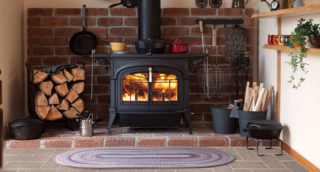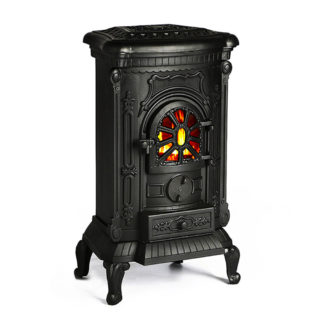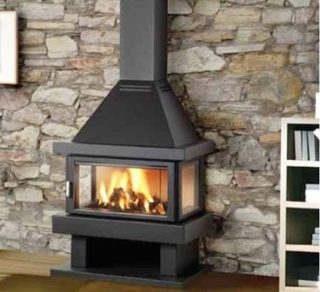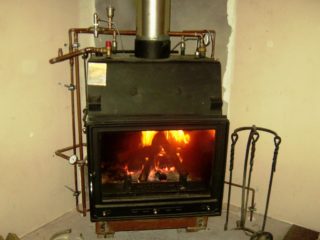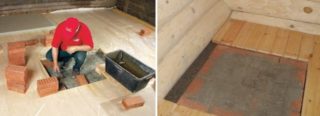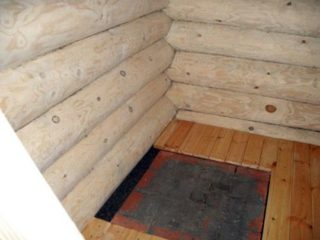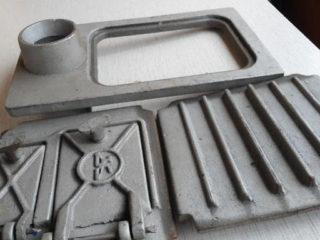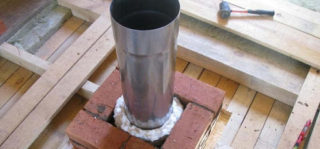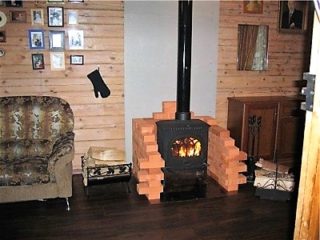Various stoves are often used as backup heating. This is due to the independence of this type of heater from the mains or gas main. The equipment of a house with a brick or stone firebox has its own difficulties primarily because of the complexity of the project. An alternative may be a cast iron stove. Models of these devices are always on sale. The homeowner needs to purchase and install such an aggregate.
Varieties of heating devices
All cast iron stoves have a housing made entirely of this metal. The shape is often represented by a box or cube that is mounted on legs. On the facade there is a firebox door and below it an ash pan. The appearance of such a product, as a rule, already has a design that is beautiful in terms of design. Functionally, products can be divided into three main categories:
- devices intended only for heating;
- hearths designed for heating and cooking operations;
- fireplaces.
When buying equipment, it is necessary to require a passport for it, so that under the guise of a cast-iron construction, you will not get ordinary steel artfully decorated by an unscrupulous manufacturer.
Cast iron is a brittle metal and can burst upon impact, so the product should be transported carefully.
Heating stove
A simple from the point of view of the device unit made of cast iron, designed to heat the house, has a construction of a stove. There are only two internal chambers - one furnace, the other for collecting ash. They are separated by grates, in the upper part of the firebox on the side or on the lid there is a chimney hole with an integrated channel shutter.
The cast iron stove works according to a simple principle. Firewood is put in a chamber and set on fire. By controlling the smoke damper at the top and the width of the holes in the blower, a stable traction of the focus is achieved. After the device has completely warmed up, the shutters can be covered so that the heat does not leave the chamber into the pipe, but heats the walls of the case and the room inside. Despite the possibility of adjusting the draft and reducing hot air emissions to the outside, such devices have a very low efficiency, sometimes not exceeding 40%. It is difficult to fully heat even a small house with such a stove.
To increase the efficiency, more fireboxes were developed in a constructive sense, where the system of moves and the principle of long burning are used. Such heaters can achieve an efficiency of 60%, which already allows them to be used as high-grade heat generators.
Devices for heating and cooking
Cooking fireplaces can be attributed to more functional devices, they allow you to heat the area and make it possible to heat or cook food. Structurally, they are very similar to potbelly stoves with the only difference being that the top plate is equipped with hotplates. The internal arrangement of simple models combines a firebox and a hob - the fire is in direct contact with it, which leads to rapid wear of the latter during intensive use. More elaborate stoves are supplemented by a steel partition plate between the wood burning compartment and the stove. In addition to these functions, some manufacturers add an oven to the product.
Advantages of the cast iron hearth of the cooking type:
- good functionality and at the same time attractive appearance of the product;
- the design of the sliding ash collection compartment allows you to clean the heater during operation of the stove;
- long burning models give an efficiency of 70%.
The most significant drawback of all cooking appliances is that it is not possible to precisely adjust the temperature of the frypot and oven. Need constant monitoring of cooking. The heat transfer power here is regulated only by the volume of burning firewood and by muting or opening the dampers.
Fireplaces pig-iron wood for the house
The main purpose of this type of equipment is air heating in the room and a decorative addition to the interior of the room. The furnace chamber has a glass door made of solid heat-resistant material or framed in a beautiful frame. The product is suitable for installation in living rooms or reception rooms where people are constantly present. The body is completely made of cast iron, including legs. The external surface can be coated with black heat-resistant matte paint or colored enamel. In the lower part of the structure there is usually a niche for laying logs where they can dry before they go on burning.
At fireplaces, the chimney hole is located at the top of the unit. This allows you to bring the pipe out of metal directly directly to the ceiling. This solution improves the efficiency of the entire system due to the fact that the entire surface of the chimney will work, giving heat to the room.
Cast-iron fireplaces are not energy-efficient devices, the emphasis here is more on an aesthetically attractive look.
How to choose a cast iron firebox
The algorithm for selecting the necessary apparatus from cast iron is quite simple and relies on the following points:
- area of the building to be heated;
- type of heating - the hearth will act as the only source of heat or be used as an addition;
- overall dimensions - this issue is important if the space (furnace) is limited in area;
- functional purpose of the heater.
Convection-type heaters, the category of which includes cast-iron equipment, are calculated by heat transfer relative to the volume, and not the area of the room. These data must be indicated in the product passport.
If you need to heat suburban housing in an unguarded area, it is advisable to buy a small collapsible cast-iron stove for a summer residence, which can be installed during your stay in the house and taken with you for a period of absence.
For a large building, two or three rooms are suitable equipment with a built-in heat exchanger. It can be connected to the wiring of the radiator system and thus get a complete thermal circuit. When implementing such a project, it is important to establish a safety group for boiler rooms.
Installation of a cast iron firebox
Thermal equipment is a ready-to-install product. Usually it is a prefabricated unit consisting of individual elements, so it requires the articulation of these parts. Despite the relatively light weight of the heater, it is not possible to install it simply on the floor, if it is not a concrete strong foundation. In all other cases, training is required. The same applies to the pipe - it should protrude above the roof level, and its passage through the building structure must be fireproof.
Tool preparation
To install the heat generator in the right place, the following tools are needed:
- Measuring tape. With its help, they are determined with the distance of the product to nearby walls or reporting points.
- Horizontal level. The product should be perfectly aligned.
- Jack. It may be necessary to level a heavy structure by lifting one of the corners and installing a substrate under the supporting leg.
- Set of wrenches. They are necessary if the heater consists of different parts fastened by a bolted connection.
All these tools are not needed when the hired professional team is responsible for the installation. Without the help of workers can not do if the weight of the product is not comparable with the strength of one person.
Installation location
There are no serious restrictions for the installation of heating equipment in a particular place, it is important that the floor is solid and not squeezed, nearby walls are non-combustible or protected from thermal effects, the place is convenient.
The operation of any solid fuel boiler or hearth is accompanied by an accumulation of dust, so it is more advisable to install the unit not too far from the entrance zone so as not to take out the garbage throughout the room.
If the stove does not represent a special decorative appeal and it can be connected to diluted water heating, it is better to put the firebox in the boiler room.
Foundation preparation
It is better to make a concrete base for the heavy weight of the heat generator. For a new building, you should immediately lay it. To do this, you must:
- Remove the soil layer to a depth of 25 cm - dig a small pit with linear dimensions that exceed the dimensions of the convector itself by a couple of tens of centimeters in length and width.
- In each corner of the pit, go deep to 80 cm with pit sizes 25x25 cm.
- Insert 4 reinforcement into the pits, driving them into the ground. In the upper part they should not go beyond the pit.
- Pour concrete pits and foundation pit at half height.
- Put a reinforcing mesh on the cement mortar and add the foundation to the end.
If it is not possible to equip the base in this way, but there is a rather rigid floor, it is enough to put a sheet of metal 3-4 mm thick on top of it, which must be fixed with self-tapping screws. Steel will additionally strengthen the floor and will serve as protection against loss of burning coals.
Installation Procedure
To install the stove, perform the following actions:
- They take out the spare parts from the packaging and check against the passport with the availability of everything necessary.
- They study the scheme where what part should be screwed, find these elements.
- Twist the two side walls from the back with a bolted connection, fixing them to the lower base.
- Screw the support legs, fix the ash pan panel and the grate group.
- Expose a partially assembled product to a permanent place.
- Install the front door with glass on the canopies and on top of everything close the lid with a hole for removing smoke.
- Insert the ash pan into the seat.
It is necessary to carefully tighten all the screws so that the refractory gaskets fit snugly at the junction. If cracks are visible in the gap, it is advisable to seal them with refractory sealant.
Installation Issues
Assembling and installing a cast iron fireplace stove does not always go smoothly. This is facilitated by such factors:
- Unsuccessfully selected place. We are talking about the inability to normally bring the pipe vertically up at the point of the furnace (the passage of communications, load-bearing elements, steel structures).
- The diameter of the chimney does not match the seat.
- In the immediate vicinity are flammable elements, from which it is impossible to retreat.
- Some parts of the furnace are poorly articulated due to casting defects.
Problems can be avoided with clear planning, taking all measurements and analysis of the building structure. When buying a product, you must carefully inspect it for quality.
Safe operation
The walls of the hearth become very hot during operation, so touching them with exposed parts of the body can cause burns. For this reason, it is forbidden to leave fireplaces unattended in the presence of young children.
The distance to flammable materials from the unit must be sufficient so that these materials do not overheat and ignite. In a room where this type of heating is used, a fire extinguisher must be in the public domain.
The long, trouble-free and efficient operation of the cast-iron convector can be counted on if the chimney is properly arranged, the pipe and ash pan are regularly cleaned, the unit is not subjected to overheating.
